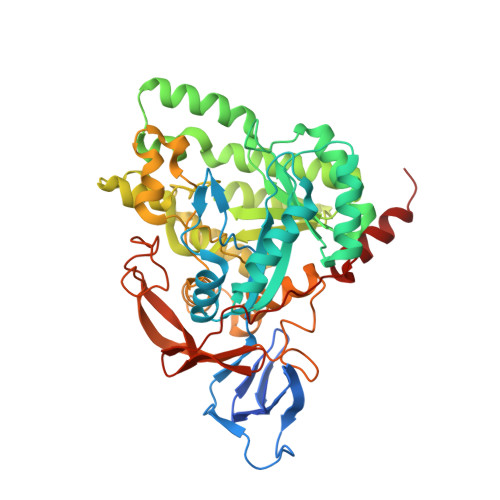Collapsin response mediator protein 2: high-resolution crystal structure sheds light on small-molecule binding, post-translational modifications, and conformational flexibility.
Myllykoski, M., Baumann, A., Hensley, K., Kursula, P.(2017) Amino Acids 49: 747-759
- PubMed: 28044206
- DOI: https://doi.org/10.1007/s00726-016-2376-z
- Primary Citation of Related Structures:
5LXX - PubMed Abstract:
Collapsin response mediator protein 2 (CRMP-2) is a neuronal protein involved in axonal pathfinding. Intense research is focusing on its role in various neurological diseases. Despite a wealth of studies, not much is known about the molecular mechanisms of CRMP-2 function in vivo. The detailed structure-function relationships of CRMP-2 have also largely remained unknown, in part due to the fact that the available crystal structures lack the C-terminal tail, which is known to be a target for many post-translational modifications and protein interactions. Although CRMP-2, and other CRMPs, belong to the dihydropyrimidinase family, they have lost the enzymatic active site. Drug candidates for CRMP-2-related processes have come up during the recent years, but no reports of CRMP-2 complexes with small molecules have emerged. Here, CRMP-2 was studied at 1.25-Å resolution using X-ray crystallography. In addition, ligands were docked into the homotetrameric structure, and the C-terminal tail of CRMP-2 was produced recombinantly and analyzed. We have obtained the human CRMP-2 crystal structure at atomic resolution and could identify small-molecule binding pockets in the protein. Structures obtained in different crystal forms highlight flexible regions near possible ligand-binding pockets. We also used the CRMP-2 structure to analyze known or suggested post-translational modifications at the 3D structural level. The high-resolution CRMP-2 structure was also used for docking experiments with the sulfur amino acid metabolite lanthionine ketimine and its ester. We show that the C-terminal tail is intrinsically disordered, but it has conserved segments that may act as interaction sites. Our data provide the most accurate structural data on CRMPs to date and will be useful in further computational and experimental studies on CRMP-2, its function, and its binding to small-molecule ligands.
Organizational Affiliation:
Faculty of Biochemistry and Molecular Medicine and Biocenter Oulu, University of Oulu, Oulu, Finland.
















